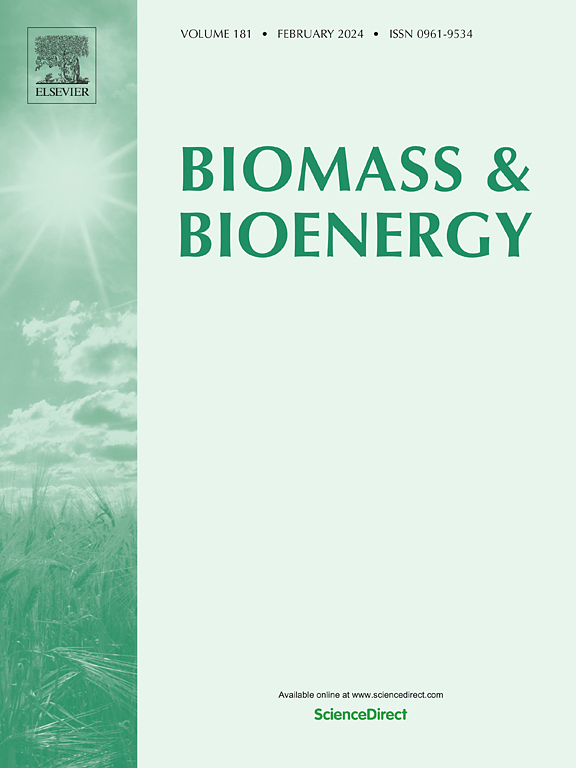在加拿大北部社区使用柳树和杨树作为生物能源为小型温室供暖的经济可行性
IF 5.8
2区 生物学
Q1 AGRICULTURAL ENGINEERING
引用次数: 0
摘要
以社区为基础的室内农场,如温室,提供全年解决方案,为加拿大北部地区提供新鲜和负担得起的食物,解决由长途运输、恶劣天气和流行病等中断造成的供应链问题。一个日益增长的趋势是从石油燃料锅炉转向生物质加热系统,以减少对丙烷、柴油或电力的依赖。为了评估温室生物质加热系统的经济可行性,在萨斯喀彻温省北部农村进行了一个案例研究,重点研究了使用本地和专用种植的柳树和杨树作为原料。该分析评估了生物质生产和收获成本、温室热量需求、生物质加热系统的资本和运营费用、能源成本以及替代传统燃料系统(包括天然气、柴油和电力)时的整体项目盈利能力。结果表明,随着温室面积从0.1公顷增加到4公顷,北方温室每公顷的年热量需求减少了60%。使用生物质锅炉的平均生产成本从6.3 GJ - 1美元到18.5 GJ - 1美元不等,假设在21年的系统寿命内每吨生物质成本为55美元。除非在占地面积超过4公顷的大型温室中使用,否则生物质锅炉与天然气相比没有利润。然而,与所有温室规模的柴油和电加热系统相比,它们被证明是具有成本效益的。敏感性分析考察了影响盈利能力的因素,如贴现率、温室大小、燃料成本、生物质、劳动力、安装和维护。燃料和生物质成本的影响最大。本文章由计算机程序翻译,如有差异,请以英文原文为准。

Economic feasibility of using willow and poplar as bioenergy sources for heating small greenhouses in Canadian Northern communities
Community-based indoor farms, like greenhouses, offer a year-round solution to provide fresh and affordable food for Canadian Northern regions, addressing supply chain issues caused by long transportation distances, severe weather, and disruptions like pandemics. A growing trend is the shift from petro-fuel boilers to biomass heating systems to reduce reliance on propane, diesel, or electricity. To assess the economic feasibility of biomass heating systems for greenhouses, a case study was conducted in rural Northern Saskatchewan focused on using native and purpose-grown willow and poplar as feedstocks. The analysis evaluated biomass production and harvesting costs, greenhouse heat demand, capital and operating expenses of the biomass heating system, energy costs, and overall project profitability when replacing conventional fuel systems including natural gas, diesel, and electricity. The results showed a 60% decrease in the annual heat demand per hectare for Northern greenhouse, as the greenhouse floor area increased from 0.1 to 4 ha. The average production cost of using a biomass boiler ranged from $6.3 GJ−1 to $18.5 GJ−1, assuming a biomass cost of $55 per tonne over a 21-year system lifespan. Biomass boilers were not profitable compared to natural gas unless used in larger greenhouses with floor areas exceeding 4 ha. However, they proved to be cost-effective compared to diesel and electric heating systems across all greenhouse sizes. A sensitivity analysis examined factors such as discount rate, greenhouse size, costs of fuel, biomass, labor, installation, and maintenance that affect profitability. Fuel and biomass costs have the highest impacts.
求助全文
通过发布文献求助,成功后即可免费获取论文全文。
去求助
来源期刊

Biomass & Bioenergy
工程技术-能源与燃料
CiteScore
11.50
自引率
3.30%
发文量
258
审稿时长
60 days
期刊介绍:
Biomass & Bioenergy is an international journal publishing original research papers and short communications, review articles and case studies on biological resources, chemical and biological processes, and biomass products for new renewable sources of energy and materials.
The scope of the journal extends to the environmental, management and economic aspects of biomass and bioenergy.
Key areas covered by the journal:
• Biomass: sources, energy crop production processes, genetic improvements, composition. Please note that research on these biomass subjects must be linked directly to bioenergy generation.
• Biological Residues: residues/rests from agricultural production, forestry and plantations (palm, sugar etc), processing industries, and municipal sources (MSW). Papers on the use of biomass residues through innovative processes/technological novelty and/or consideration of feedstock/system sustainability (or unsustainability) are welcomed. However waste treatment processes and pollution control or mitigation which are only tangentially related to bioenergy are not in the scope of the journal, as they are more suited to publications in the environmental arena. Papers that describe conventional waste streams (ie well described in existing literature) that do not empirically address ''new'' added value from the process are not suitable for submission to the journal.
• Bioenergy Processes: fermentations, thermochemical conversions, liquid and gaseous fuels, and petrochemical substitutes
• Bioenergy Utilization: direct combustion, gasification, electricity production, chemical processes, and by-product remediation
• Biomass and the Environment: carbon cycle, the net energy efficiency of bioenergy systems, assessment of sustainability, and biodiversity issues.
 求助内容:
求助内容: 应助结果提醒方式:
应助结果提醒方式:


